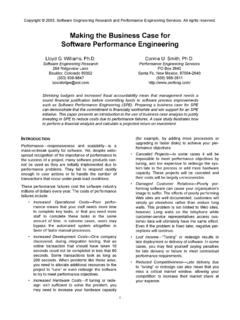Transcription of DashCommand Users Manual - Palmer Performance …
1 Introduction DashCommand is an app that acts as an advanced in-car computer. It is currently available for Windows, iOS (iPhone/iPod Touch/iPad), and Android. At the time of this writing, the most recent version of DashCommand is DashCommand can display a lot of information that is missing from your vehicle's factory dashboard, as well as calculate additional data not available directly from your vehicle. All of this data can be customized to display using any number or combination of gauges, using our free SkinXL Tool -- or by downloading extra dashboards designed by other Users . Before we start, DashCommand is a read-only diagnostic logging tool. It cannot do any flashing, modifying, tuning, CASE relearns, injector tests, or any other bi-directional control. Notice anything missing from this Manual ? Please contact and help us improve! Main Menu This is the first screen you will see when you start DashCommand , it allows you to access all of the different features DashCommand has to offer.
2 At the top the menu will show your currently selected vehicle, and the current date/time. The date changes to a status message when the software is busy connecting, or when doing any other lengthy operations. The connection button indicates the current connection status. It is orange when you are not connected to a vehicle, yellow while a connection is in progress, or green when you have successfully connected. The available sub-screens are: Connection Race Track Dashboards Gauges Performance Inclinometer Skid Pad Diagnostics Vehicle Manager Advance Settings Console Data Grid Settings Connection This main menu option attempts to open a connection to the vehicle. For most Users , you'll want to have already selected a vehicle from the Vehicle Manager before you try to connect. Also, you will need to make sure you have the correct Interface Type selected in Settings. You can see that it is opening the OBD-II connection from the text in the status bar at the top.
3 If the connection was successful, the orange circle in the connection button will turn green and say Connected -- indicating you are currently connected. If this circle turns orange at any point, the connection to the vehicle has been lost. Race Track The Race Track uses your phone's GPS to map your course around any track, anywhere. If you have cell data available, it will download the Google Maps image to use as the background. It also color codes your path. Green is acceleration, yellow is no acceleration / coasting, and red is braking. There is a Skid Pad visible at the bottom, as well as some information such as GPS calculated speed, GPS accuracy, and distance travelled as calculated by GPS. There is no limit to how long, or how far, the Race Track will map. It will never erase your previous course (unless you tell it to, by selecting Zero from the menu), and will automatically zoom out if you leave the screen area. It is only as accurate as the GPS in your device, some phones may be more accurate than others.
4 Dashboards The Dashboards screen is the place you will likely spend most of your time in DashCommand . This is where you can view live data through a number of gauges called Skin Sets. A Skin Set is a collection of dashboards, each dashboard defining exactly 1 screen worth of gauges. You can change to a different skin set at any time by going to Settings. The default Tuxedo skin is a very complete, detailed skin showing nearly every gauge possibly available from your vehicle. Not all vehicles will support all PIDs, so some PIDs may be unable to be displayed. Here is a brief overview of each: It has a Performance dashboard for RPM, speed, power, torque, and boost. It also has a Fuel Economy page showing your instant and average MPG, as well as an MPG graph over the last 3 hours. It has gauges for fuel level remaining, and distance to empty. You can press the Fuel Economy tab a second time to gain access to a sub menu with a reset button. There is a Trip Stats page showing a very large number of trip stats.
5 Everything from min/max engine speed, to driving time, and even calculated CO2 emissions and fuel costs. Again, you can press this tab to reveal additional sub-trips, or a reset button. The Engine dashboard shows various engine health gauges. MAP, MAF, intake temp, timing advance, and fuel trims are just a few. You can touch the Engine tab again to get to the second Engine dashboard. The final dashboard, Fill-up, is where you can enter fuel cost, and the number of gallons you added to the tank. This screen is completely optional, and is only used to help calibrate the fuel economy PIDs a little more. IMPORTANT NOTE: If you are not monitoring with DashCommand for the ENTIRE tank, DO NOT USE THIS SCREEN. Using this screen for an incomplete monitoring session will falsely, and drastically, skew your economy numbers. Many gauges are able to be touched and toggled to a different gauge, other gauges to touched to cycle between the current, min, and max values for that gauge.
6 Touching the gauge in the area of the numbers displayed will switch to the alternate display. Gauges Gauges is a way to add an easy custom gauge to be viewed on a screen. When you open Gauges you will see a screen like the one on the left. To edit, you simply touch the screen and an edit button will drop on the screen like the center picture. After pressing the edit button at the top, you will open the edit options like the right image. Once the edit menu is open, you can touch a gauge to edit it or move it, or you can click the bottom buttons to add another page to put gauges on or add another gauge. To edit a gauge, touch a gauge while the edit bar is at the bottom and you will see it open a menu like the one pictured on the left. If you click on Edit Gauge you will see the gauge edit menu like the center picture. From there you select your Style and Type, then set the PIDs you want to be used. Make sure you set all of the PIDs for Needle, LCD, and Marker to be the ones you want.
7 You can also click a box inside of the Marker PID to remove the marker and not have one displayed. Now you have your PID, you need to set the limits (right picture). Low Limit is the lowest number on the gauge (can be a negative number), High Limit is the largest number on the gauge. Multiplier is used to make the displayed number smaller, for example on RPM you would see 1000,2000,3000, etc displayed, but if you set the multiplier to 1000 , it would show 1,2,3, etc. Do not change you High Limit with the multiplier, we will do it for you automatically. Performance Performance is a quarter mile and speed timer Performance page. With this page you can record your vehicles acceleration Performance . On the bottom left you have a toggle to change from mile to 0-60. On the mile timer, you have the optional start button in red, you can press that to start the stage light countdown so you can get a reaction time with your results, otherwise you just start moving to start the recording.
8 Stop and start again to record a new time. DashCommand will fill the bars of each increment as you cross 60 feet, 330 feet, 1/8 mile, etc. (You can stop after a 1/8 mile run and see results, you don t have to go a full mile. You can get your results break down by pressing the green results button. The 0-60 timer will track your 0-60 time by default. You simply start moving and the timer starts, when you reach 60 it will show your time. It is not only a 0-60 timer, you can hit the edit button and change it to any start time and stop time. The time will start when you reach your starting speed and stop at your stop speed. To try again, just slow down below your minimum speed and start again, no buttons to press, it is fully automatic. The reset button will clear your Fastest and Last ET numbers. Skid Pad This Skid Pad uses the accelerometer built into the phone to calculate G-Forces in any given direction. It puts a dot at the corresponding point for every reading.)
9 DashCommand also saves Skid Pad data even while you are in a different screen, and draws it all onto the Skid Pad once you return. There is no limit to the amount of time you can monitor with the Skid Pad, and it will not ever erase your previous points. You can manually reset the Skid Pad points from the menu. To avoid Users having to perform a Manual calibration, the Skid Pad automatically calibrates itself to your phone's orientation when you launch DashCommand . If you started DashCommand before you had the phone situated in your mount, go to the menu and select Zero to recalibrate. Also, because of the orientation sensitive nature of this feature, the orientation is locked to the current orientation while you are viewing the Skid Pad. Inclinometer This simple feature uses the accelerometer in your phone to calculate your current incline for you off-road fans. There are 2 different views available, and a Toggle View option in the menu switches between them. Just like the Skid Pad, you will need to Zero this screen if you started DashCommand while holding the phone.
10 Diagnostics The Diagnostics page allows you to read and clear trouble codes, and view the current emission monitor status. Notice that clearing the trouble codes will also clear all emissions monitor data as is legally required. For a few select vehicles, you can only clear the trouble codes with the engine off (key on, engine not running). The Diagnostics view will give a short code description for all codes that are OBD-II standardized. Manufacturer-specific codes can still be read, but they will not have a description. Each monitor will be reported as passed/complete, failed/not complete, or not supported. A passed monitor is indicated by a green checkmark, a failed monitor by a red !, and an unsupported monitor by a yellow circle. Vehicle Manager The Vehicle Manager is one of the first places you will visit in DashCommand . This creates and manages your list of vehicles. Data logs are stored according to the vehicle you have currently selected, as well as data such as the fuel economy history and trip stats.






